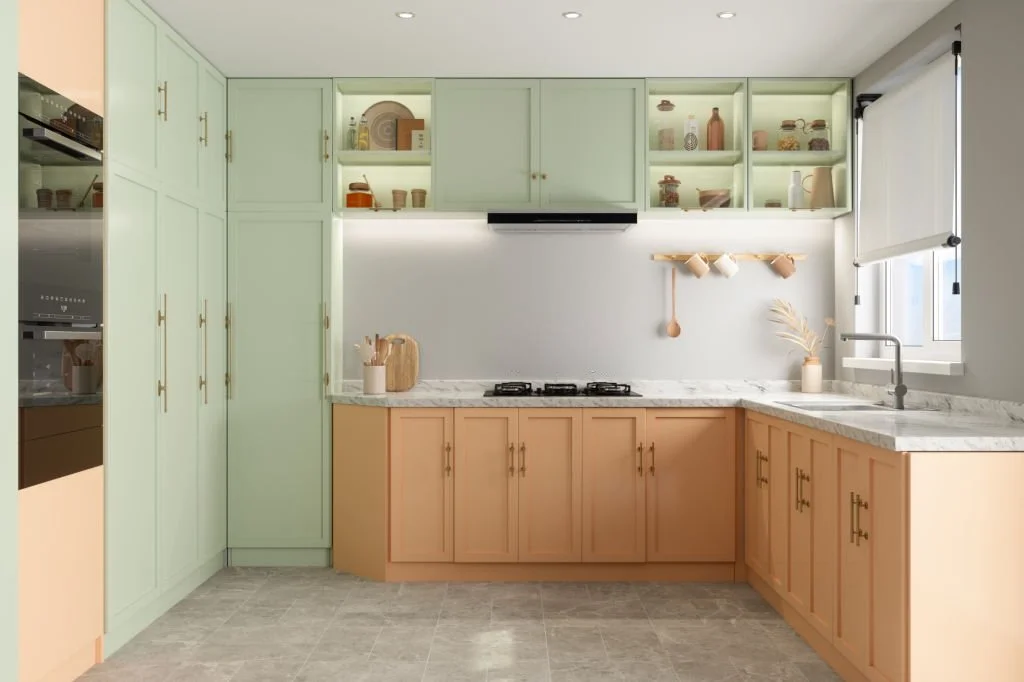
To use TSP before painting cabinets, mix a half cup of TSP with two gallons of warm water, wear rubber gloves, soak a sponge in the TSP solution, and start wiping down the cabinets. Focus on corners and any other areas where grease can build up. Rinse off the TSP with clean, warm water and let everything dry before sanding, filling, priming, and painting.
When it comes to painting your kitchen cabinets, you might be tempted to dive right in, but proper surface preparation is key to achieving a professional, long-lasting result. One essential step in preparing your cabinets is using a powerful cleaning agent called trisodium phosphate (TSP).
In this article, we’ll guide you through the process of how to use TSP before painting cabinets, helping you achieve a perfect finish that will last for years.
What is TSP and Why Should You Use It?
TSP: The Ultimate Cleaning Agent
Trisodium phosphate, commonly known as TSP, is a powerful cleaning agent known for its ability to remove grease, dirt, and stains from surfaces. It’s often used by professional painters to prepare surfaces for painting, ensuring optimal adhesion and a smooth finish.
The Benefits of Using TSP Before Painting Cabinets
If you’re wondering why you should use TSP before painting cabinets, it’s simple: TSP not only effectively removes dirt and grease, but it also helps to degloss the surface, making it easier for the paint to adhere. By using TSP as part of your cabinet preparation process, you’ll significantly improve the longevity of your paint job and achieve a professional-looking result.
Safety Precautions When Using TSP
Before we dive into the process of using TSP, it’s essential to go over some safety precautions. TSP is a powerful chemical that can be harmful if it comes into contact with your skin or eyes, so it’s essential to take the proper precautions when handling it. Here are some tips to ensure your safety when using TSP:
Wear Protective Gear
Always wear gloves and protective eyewear when using TSP to avoid skin irritation and eye damage. Avoid getting the solution on your skin or in your eyes, and keep TSP away from children and pets.
Use TSP in a Well-Ventilated Area
TSP can release fumes that can be harmful if inhaled, so it’s essential to use it in a well-ventilated area. Open windows and doors to ensure proper ventilation, or consider using a respirator to protect yourself.
Dispose of TSP Safely
After using TSP, dispose of it according to your local regulations. TSP is considered a hazardous material and should not be poured down the drain or thrown in the trash. Follow the instructions on the label or contact your local waste management facility for guidance.
Follow Instructions Carefully
Read the manufacturer’s instructions on the TSP package carefully, and follow the recommended mixing ratios. Avoid overusing TSP, as it can damage the surface you’re cleaning.
How to Use TSP Before Painting Cabinets
Now that we’ve covered the safety precautions let’s dive into how to use TSP before painting cabinets. Here’s a step-by-step guide to follow:
Step 1: Remove Cabinet Doors and Drawers
Remove the cabinet doors and drawers from the cabinet boxes. Make sure you label each one in an inconspicuous spot, so you know where everything needs to go when you’re putting it all back in place.
Step 2: Mix the TSP Solution
In a large bucket, mix a half cup of TSP with two gallons of warm water. Stir the mixture until the TSP is dissolved.
Step 3: Clean the Cabinets
Soak a sponge in the TSP solution and start wiping down your cabinets. Focus on corners and any other areas where grease can build up. Be sure to wear gloves and avoid direct contact with your skin.
Step 4: Rinse Thoroughly
Using a different sponge or a rag, rinse off the TSP with a bucket of clean, warm water. Rinse thoroughly to ensure all the TSP is removed from the surface.
Step 5: Let Cabinets Dry
Let the cabinets dry completely before painting. It’s essential to wait until the surface is entirely dry, so the paint adheres correctly.
Using TSP is a crucial step in preparing your cabinets for painting. By following these steps and taking the necessary safety precautions, you’ll be able to achieve a professional, long-lasting finish on your cabinets.
Drawbacks and Alternatives to TSP
Potential Drawbacks
While TSP is an effective cleaner, it has some potential drawbacks to consider. One concern is its impact on the environment, specifically eutrophication. Additionally, TSP can darken certain types of wood, such as mahogany, which may not be desirable.
Alternatives to TSP
There are alternatives to TSP that can be used for cleaning cabinets before painting. Some homeowners prefer to use vinegar and baking soda to clean their cabinets, while others opt for plant-based cleaners or natural degreasers. However, it’s important to test any cleaner on a small, inconspicuous area of the cabinet before using it on the entire surface. Additionally, be sure to follow the manufacturer’s instructions and safety precautions when using any cleaning product.
Tips for Using TSP Effectively
Here are some additional tips to help you use TSP effectively and get the best results:
Start with a Clean Surface
Before you start using TSP, make sure to remove any loose dirt or debris from the surface of the cabinets. Use a dry cloth to wipe down the surface and remove any dust or dirt.
Use a Soft-Bristled Brush
When scrubbing the cabinets with TSP, use a soft-bristled brush to avoid damaging the surface. A soft-bristled brush will help you to scrub away any dirt or grease without scratching the surface of the cabinets.
Work in Small Sections
When cleaning the cabinets with TSP, work in small sections to avoid the solution drying on the surface. Scrub each section thoroughly before moving on to the next one.
Rinse Thoroughly
It’s essential to rinse the cabinets thoroughly with clean water after cleaning with TSP. Any leftover TSP on the surface can affect the adhesion of the paint and result in a poor finish.
Use TSP in a Well-Ventilated Area
TSP can release fumes that can be harmful if inhaled, so it’s crucial to use it in a well-ventilated area. Open windows and doors to ensure proper ventilation, or consider using a respirator to protect yourself.
Conclusion
Using TSP is an essential step in preparing your cabinets for painting. By following the steps outlined above and taking the necessary safety precautions, you can achieve a professional, long-lasting finish on your cabinets. Remember to work in small sections, use a soft-bristled brush, and rinse thoroughly to get the best results. With a little effort and patience, you can transform your cabinets and give your kitchen a fresh, new look.
If you’re uncomfortable using TSP or prefer a more eco-friendly option, there are several alternatives available that can still provide good results. Whatever method you choose, be sure to follow the instructions carefully and take proper safety precautions to ensure a successful outcome.



